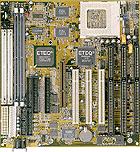Soyo SY-5EH5 MVP3 Super7 Board
by Anand Lal Shimpi on June 16, 1998 1:09 PM EST- Posted in
- Motherboards
Anand Tech Report Card Rating
92/A-
| CPU Interface | Socket-7 |
| Chipset | ETEQ/VIA MVP3 |
| L2 Cache | 512/1024KB |
| Form Factor | AT (w/ AT & ATX PS Connectors) |
| Bus Speeds | 66 / 75 / 83 / 100 / 112 MHz |
| Clock Multipliers | 1.5x - 5.5x |
| Voltages Supported | 2.0v - 3.5v (0.1v steppings) |
| Memory Slots | 2 168pin DIMM Slots
(EDO/SDRAM) 2 72pin SIMM Slots (EDO/FPM) |
| Expansion Slots | 1 AGP Slot 3 PCI Slots (1 Full Length) 3 ISA Slots (1 Shared / 1 Full Length) |
| BIOS | AWARD PnP BIOS |
| Out of the box you'll probably notice an interesting feature of the SY-5EH5, the presence of a non-VIA/non-ALi Super7 chipset or so it would seem. The Northbridge Chip on the 5EH5 bears the noticeable ETEQ logo, something rarely seen in the motherboard industry, fortunately for the sake of keeping the Super7 world from becoming any more complex the ETEQ chipset is nothing more than a re-labeled VIA MVP3 chipset. The VIA Bus Master Drivers work perfectly fine on the 5EH5, as do the VIA AGP GART VxD's. |  |
The design of the board should be quite familiar to most that have followed the Super7 scene develop, a baby-AT form factor motherboard with the ever so popular 3/3/1 PCI/ISA/AGP expansion slot configuration accented by 2 DIMM and 2 SIMM slots which provide ample room for growth on the memory size of things. The 3/3/1 slot setup on the 5EH5 leaves room for a single full length ISA card to be installed in the first ISA slot and enough room is provided for a single full length PCI card, such as a Voodoo2, to be installed in the last PCI slot (the remaining two slots in both cases remain length restricted as a result of the placement of the CPU Socket). Unlike other AT Super7 motherboards, the 5EH5 does allow for a single Voodoo2 configuration which has been proven to be an excellent complement to the AMD K6-2, a chip that simply craves fast 3D performance.
For those of you with the possibility of an ATX case in your future, Soyo has included both AT and ATX Power Supply connectors for convenience above all. This was a feature that was mysteriously left out of FIC's AT Super7 design, possibly to force users to go the newly released FIC PA-2013's ATX path if they wanted an ATX PS connector on the board. Fortunate enough for users that must have an AT Super7 board today that Soyo had the insight into what the market desired to provide both styles of connectors on the board.
Like its VA-503+ competitor, the 5EH5 does have its share of hidden traits. The elusive 112MHz FSB setting is present on the board and can be achieved by setting switches 4 -6 on the SW1 Dip Switch block to the following settings respectively: off, on, on. Another unique feature of the 5EH5 is the presence of the Smart Detect CPU Voltage Jumper, by capping the jumper the board automatically detects and configures the core voltage to fit your CPU's needs properly. If you happen to have an older, non-Intel, CPU then you may want to disable this function by removing the jumper on JP4. As you may be able to tell, the Jumper/Dip Switch setup on the Soyo 5EH5 is a piece of cake in comparison to that of the FIC VA-503+, so if you happen to be a beginner this may tilt the balance in favor of Soyo's unique production.
Additional features include an optional 1MB L2 cache, enabling a full 256MB Cacheable Memory Area with a 512KB L2 cache shipping standard on most motherboards. The performance difference between the two versions is minimal, and is hardly reflected in real world situations, sometimes it is just a luxury feature you may or may not opt to go with. The 512KB boards are limited by a 128MB cacheable memory area, once again that is a feature that may or may not discourage you from purchasing the 1MB board over the 512KB. A general rule of thumb is that if you don't foresee yourself needing more than 128MB in the next year, save the $10 and go for the 512KB board.
Documentation, documentation, documentation. The downfall to any great motherboard seems to always be poor written documentation, and in spite of all of the Soyo 5EH5's strengths its apparent lack of a written manual (all that is packaged with the board AnandTech received for testing was a "One Sheet Manual", a useful yet incomplete set of written documentation outlining basic setup information) and any sort of driver support packaged with the motherboard does hurt the overall value of the product. Aside from that, the only other complaint is the lack of a 2.3/2.4v core voltage setting to allow overclocking of the K6/K6-2 300 to 350MHz, there is a fine line separating this board from the VA-503+...a few jumpers and 2 SIMM slots seem to be among the most obvious, it really boils down to a feature comparison while the upper hand in performance goes to FIC.
UPDATE: According to many SY-5EH5/M owners, their motherboards shipped with an excellent manual located on a bundled CD-ROM which also happened to contain all necessary drivers (I have received the PDF file located on the CD-ROM, definitely a well laid out manual). The manual also documented 0.1v core voltage steppings from 2.0v to 3.5v, looks like Soyo does have a winner on their hands.










0 Comments
View All Comments